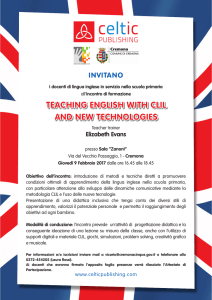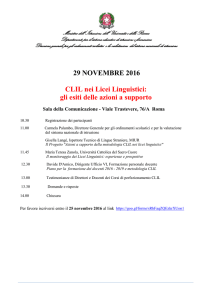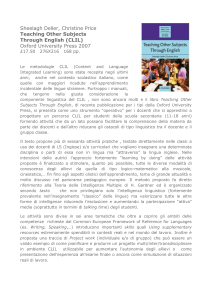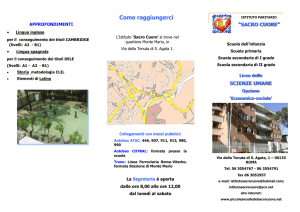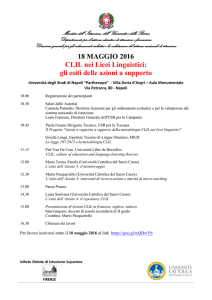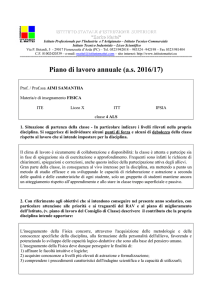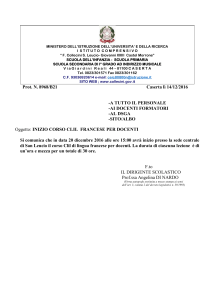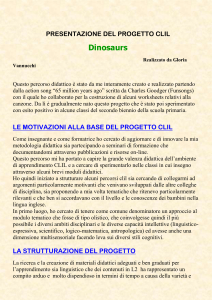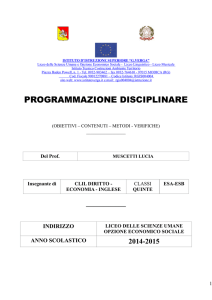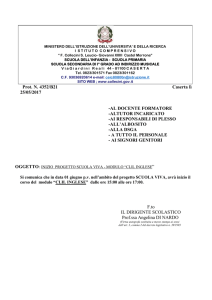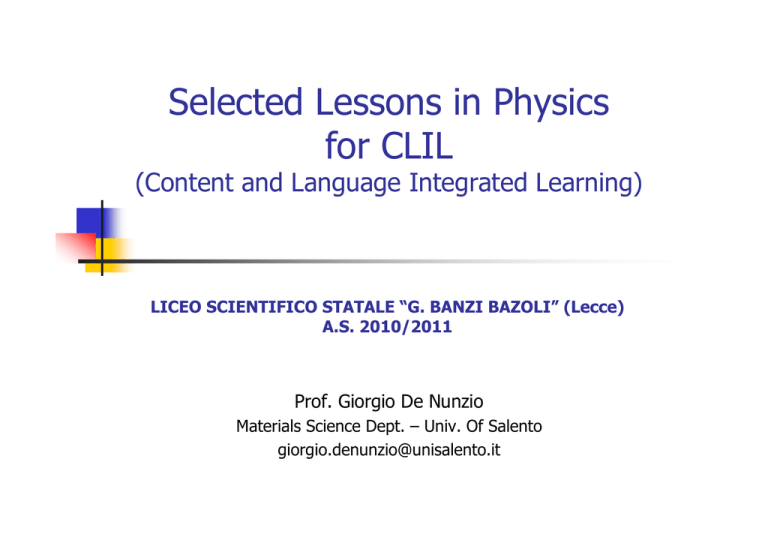
Selected Lessons in Physics
for CLIL
(Content and Language Integrated Learning)
LICEO SCIENTIFICO STATALE “G. BANZI BAZOLI” (Lecce)
A.S. 2010/2011
Prof. Giorgio De Nunzio
Materials Science Dept. – Univ. Of Salento
[email protected]
INTRODUCTION: PHYSICS!
There are two ways to live your life - one is
as though nothing is a miracle, the other is
as though everything is a miracle.
- Einstein
Who I am
Giorgio De Nunzio
Graduated in Physics in 1991 at the University of
Salento (Lecce, Italy), PhD in 1995 at the Université de
Montpellier II (Montpellier, France).
Since 2001, full-time Researcher and Adjunct
Professor at the University of Salento
Research fields: the application of Physics and
Informatics to medicine and to the territory (for the
safeguard of environmental, heritage and cultural
assets).
Main interests: Medical Physics, Medical Imaging,
Computer Assisted Detection systems, Neural Networks
Objectives
Become able to
understand a physics lesson in English
read and understand physics English texts
write physics text in English
talk about physics subjects in English
The official language in this classroom
is English!
CLIL
Double focus:
The foreign language
The disciplinary content (Physics)
CLIL lessons should use 20%-90% foreign
language
Introduce concepts in the foreign language,
then recall them in the mother language
CLIL in Europe
Primary or secondary school, 2004/2005
Usual CLIL school teaching
CLIL as pilot projects
Both pilot projects and usual
school teaching
No CLIL whatsoever
Source: ‘CLIL at school in Europe’
2006 Eurydice.
Teaching strategy
Listening
Writing (a lot in the test days, less in the other
lessons)
Speaking (more and more, as time passes..)
Learn by doing (as much as possible)
Input redundancy (hoping not to bother you!)
Micro-language learning (specific lexicon)
Course plan 1 (ok, in Italian…)
Attività previste
1
1. Presentazione del Corso
2. Analisi delle competenze linguistiche
(test di ingresso)
3. Lezione sulla compilazione di una
relazione sperimentale di Fisica
4. Presentazione dei software per la
realizzazione di tabelle e grafici
Contenuti
1. Presentazione su CLIL e il Corso
2. Somministrazione scheda di rilevazione
competenze generali e specifiche in lingua
inglese
3. Schema di una relazione di laboratorio (in
Inglese)
4. Software: presentazione programmi per la
realizzazione di tabelle e grafici (in Inglese)
2
Lezione su:
misure, errori, e cenni di Statistica
Errori assoluti e relativi, propagazione dell’errore,
parametri statistici fondamentali
3
Lezione su:
Cinematica: moto rettilineo uniforme e
uniformemente accelerato
Leggi fisiche del moto rettilineo uniforme e del moto
uniformemente accelerato.
4
Lezione su:
le forze, combinazione di forze, equilibrio,
Leggi fisiche sulle forze, la loro composizione, concetto di
equilibrio.
5
Lezione su:
Dinamica: leggi del moto
Le tre leggi del moto
Course plan 2
Attività previste
REMEMBER
REMEMBERTO
TOWRITE
WRITE
NAME
NAMEAND
ANDCLASS
CLASSON
ON
EVERY
EVERYWORK!
WORK!
Contenuti
6
Verifica intermedia
Somministrazione scheda per rilevazione competenze
linguistiche specifiche (microlingua) e competenze
disciplinari acquisite
Somministrazione esercizi sui software adoperati
7
Lezione su:
carica elettrica e campo elettrostatico
Carica elettrica e campo elettrostatico, Legge di Coulomb
8
Lezione su:
conduttori e correnti
Corpi conduttori e isolanti, corrente elettrica e suoi effetti
9
Lezione su:
campo magnetico
Campo magnetico, moto di cariche in un campo
elettromagnetico, induzione
10
Verifica finale
Somministrazione scheda per rilevazione competenze
linguistiche specifiche (microlingua) e competenze
disciplinari acquisite
Somministrazione esercizi sui software adoperati
Thanks for your attention (?)

